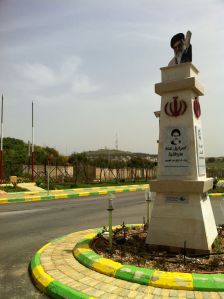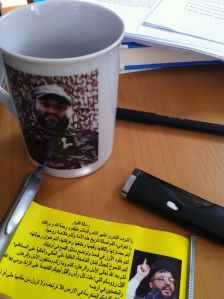You really could be in Iran, traveling the roads of Lebanon’s south. The billboards of the martyrs look newer, the young men honored by them having perished not in the 1980s, when Iran and Iraq fought to the death, but just five years ago, when Israel launched an assault on the stronghold of Hizballah, the Lebanese Shiite militia sponsored by Tehran. But those blue and yellow octagons posted on the roadsides? The ones with the pair of hands cupping it from the bottom? These are collection boxes of the Imam Khomeini Relief Committee, a staple of Iranian byways. There’s even a tattered poster or two welcoming President Mahmoud Ahmedinejad, who paid a visit last October, just walking the property.
But the centerpiece is the traffic circle in Kfar Kila, the Lebanese town tucked right against the U.N. Blue Line, mere yards from Israel. The curbs are painted the colors of Hizballah but the monument is very much to Iran. That’s Grand Ayatollah Ruhollah Khomeini on the plinth, his kohl-eyed glare captured well in the stenciled marble plate, as is the black turban. Above him stands the logo of the Islamic Republic of Iran, a stylized rendering of “Allah” in red. (I once saw a young mullah making his way through a crowd on Revolution Day in Tehran, taking a step, bending, taking a step, bending. He was plucking up leaflets that had been discarded on the asphalt, tearing the red logo out, sticking the torn circle of paper in his pocket, then bending to the next one. He explained he was fulfilling a religious instruction not to step on the name of God, but in what amounted to a 10-mile-square fairground strewn with the things it was a job for Sisyphus. His young son looked at him with wondering eyes.)
The fellow at the top, waving, would be Ayatollah Ali Khamenei, the current Supreme Leader of Iran. He always waves with his left hand, the right having been blown off in 1981 by a bomb planted by the Mujahedin el-Khalk Organization, then a rival to power. Though Ahmedinejad is the figure the West loves to hate, Khamenei is the one President Obama wrote to, fruitlessly, after taking office; no one holds more power.
Also worth noting: The hill, just behind the fence. With the tower on top? That’s the town of Metula, the northernmost town in Israel, and doubtless the reason for the Iranian showiness. A few yards away, the souvenirs on offer in a tourist gift shop run much more to the Lebanese: All manner of Hizballah flags and tee-shirts — and a curious assortment of items featuring the bespectacled likeness of Hassan Nasrullah, the party’s charismatic leader. For whatever reason, there’s something of 007 in his chachka: a seemingly ordinary butane lighter becomes, with the flick of a switch, a pin spot throwing the color image of a smiling Nasrullah. On a fountain pen, a secret compartment produces a banner featuring Nasrullah on one side and on the other, a chubby man in combat fatigues. So this is Imad Mughniyah, the longtime terror chief of Hizballah, said to have carried out every operation from the Beirut barracks bombings to the attack on the Israeli embassy in Buenos Aires. Until he died in a 2008 car bombing, believed to have been orchestrated by Israel’s Mossad, no one knew what he looked like. Now he’s on coffee mugs.



